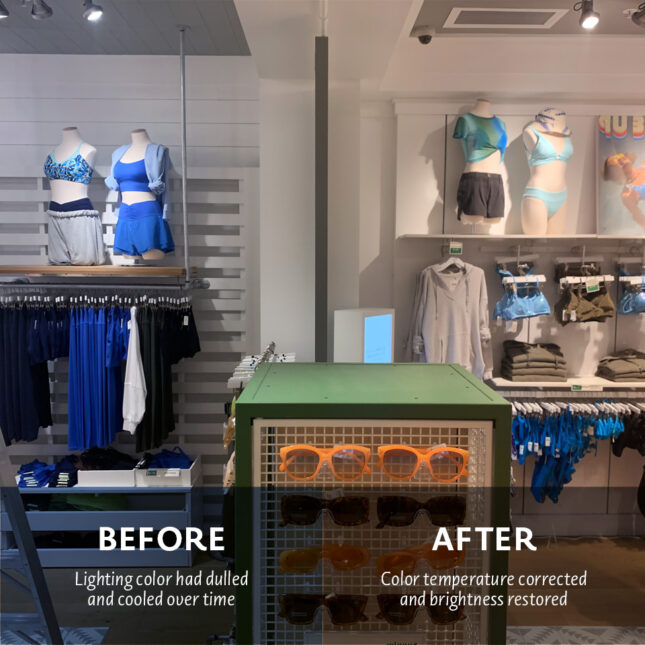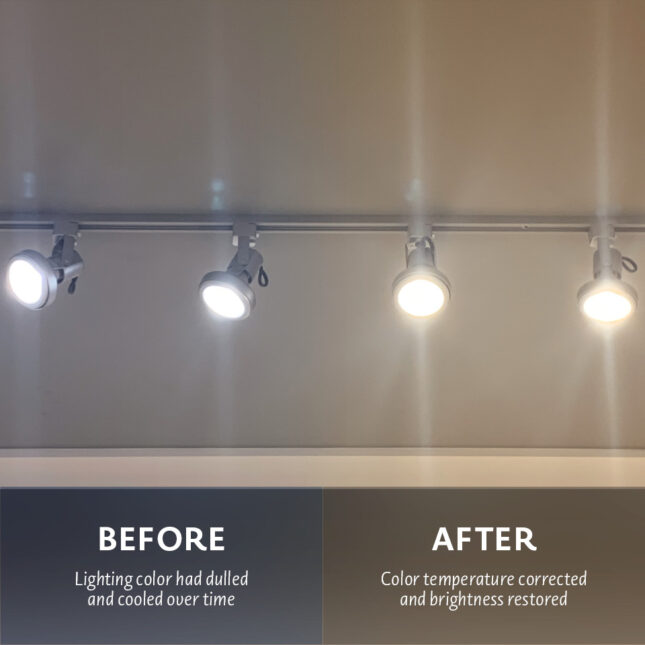Posted: November 14, 2023
By: Editorial Team
Many businesses have upgraded from fluorescent to LED for an energy-efficient, long-lasting lighting solution. But even LEDs begin to show signs of decreased performance before the end of their lifespan. An LED is considered to be at its end of life at L70, or when the lumen output has decreased to 70% of its initial output. On average, this can be between 50-100k hours.
When considering an LED-to-LED lighting conversion, there are a few questions to ask:
- When is the right time to consider an LED lighting upgrade?
- Why would an upgrade possibly be needed before their life span is complete?
- Who is the right LED lighting distributor for the job?
Common Signs of LED Lighting Failure
Whether you’re in year five or year 10, knowing when to consider an LED-to-LED lighting conversion is key. Some signs to look out for include:
- Reduced lighting levels
One of the most noticeable signs that LEDs may be nearing the end of their life is a noticeable decrease in brightness. LED bulbs typically become dimmer over time (not suddenly), so it may be hard to notice day-to-day. How long the bulbs last in your facility depends on usage. Healthcare and retail locations that are open 24/7 may need their LED lighting solutions replaced every 5–8 years. Office and educational buildings may be able to get the full 10-year use before replacements are necessary.
- Color shifting
Have you noticed that some lights may develop a yellow hue? As LEDs age, their colors may shift away from the originally intended color temperature, which is a sure sign that they are not performing as they should. It’s most noticeable in street or parking lot lights at night, but it can affect a range of fixtures.
- Inconsistency
Uneven or inconsistent lighting across the LED bulb array can be a sign of failing LEDs. Some parts of the array may appear brighter or dimmer than others. You may notice dark spots in the lighting pattern if the bulb or fixture has completely failed.
- Flashing and/or buzzing
While flickering or noisy lights may be a sign of an electrical issue, it could also be due to a failing LED driver. It’s very important to investigate and address the problem immediately to prevent further damage or a life-threatening incident.
- Heat emission
LED lighting solutions should remain relatively cool while in use. Excessive heat coming from the LED bulbs or fixtures could indicate a problem with the heat sink or driver, which may eventually lead to LED failure.


4 Reasons to Upgrade LED Lighting Before Failure
Although LED lighting is not brand new, LED lighting solutions are continuously evolving. LED-to-LED conversion, in a timely manner, is essential to benefit from these advancements and meet changing needs.
In addition to failing fixtures, here are four reasons to upgrade your LED lighting.
1. Enhance Lighting Quality
At the beginning of the LED life span, the light quality matches your desired design. As time goes by, the quality of light and color rendering decreases, and the design your brand requires is no longer being met. A timely LED-to-LED conversion can keep your design a reality.
2. Design and/or Space Changes
LED lighting solutions offer a wide range of options when it comes to design, fixture type, color temperature, and so much more. If your design goals or the use of your space has changed, upgrading the LED lighting solution to better match your goals may be a wise choice.
3. Adopt Smart Lighting
Looking to integrate smart lighting features into your space? An LED-to-LED conversion may be necessary to replace non-smart fixtures. Smart LED lighting control systems allow for flexible lighting and provide greater energy savings. Integrated controls can respond to occupancy levels, be programmed to run at specific times of the day, and adjust lighting intensity to match the amount of natural daylight in a space.
4. Improve Energy Efficiency
With the quality of LED bulbs and fixtures continuing to improve, if your LED lighting is over five years old, upgrading to more energy-efficient LEDs can lead to long-term cost savings.
Your Commercial Lighting Upgrade Partner
There are many solutions to consider when thinking of an LED lighting upgrade. The solution and timing should align with your long-term goals. That is why it’s imperative to have a lighting distributor and partner by your side to help you navigate the world of commercial LED lighting, from energy savings to new technology and, ultimately, to selling the value across your organization. Contact us online or call 800.686.6351 to talk about your next project.
Speak with lighting & electrical distribution experts today.
Related Posts:



